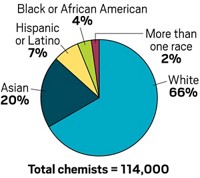Advertisement
Grab your lab coat. Let's get started
Welcome!
Welcome!
Create an account below to get 6 C&EN articles per month, receive newsletters and more - all free.
It seems this is your first time logging in online. Please enter the following information to continue.
As an ACS member you automatically get access to this site. All we need is few more details to create your reading experience.
Not you? Sign in with a different account.
Not you? Sign in with a different account.
ERROR 1
ERROR 1
ERROR 2
ERROR 2
ERROR 2
ERROR 2
ERROR 2
Password and Confirm password must match.
If you have an ACS member number, please enter it here so we can link this account to your membership. (optional)
ERROR 2
ACS values your privacy. By submitting your information, you are gaining access to C&EN and subscribing to our weekly newsletter. We use the information you provide to make your reading experience better, and we will never sell your data to third party members.
Careers
Cracking The Concrete Ceiling
Japanese government gets behind efforts to increase the number of women scientists in the country
by Pamela Zurer
January 2, 2006
| A version of this story appeared in
Volume 84, Issue 1

FROM PACIFICHEM
Biochemist Akiko Tsugawa has heard women chemists in the U.S. complaining about the "glass ceiling" impeding their careers. In Japan, she said, women "don't face a glass ceiling but a 'concrete ceiling.' We can't even see what possibilities might be available."
Now a professor at Tokyo Medical & Dental University, Tsugawa was one of five Japanese women who took part in the symposium "Women Chemists: Past, Present & Future" at the 2005 International Chemical Congress of Pacific Basin Societies (Pacifichem). They described the difficult position of women scientists in Japan and some steps being taken to change the situation.
The symposium was organized by E. Ann Nalley, now president of the American Chemical Society; Yoshie Souma, emeritus adviser at Japan's National Institute of Advanced Industrial Science & Technology; and Geoff W. Rayner-Canham, professor of chemistry at Memorial University of Newfoundland.
"In visiting other countries and speaking with women all over the world, I've discovered we share common problems," Nalley said. "At this symposium, we want to explore solutions as well as the problems women face as they advance in their careers."
In Japan, symposium attendees learned, efforts are under way to increase the number of women scientists in the country and to improve working conditions so that fewer women will drop out of the field. The government, Tsugawa noted, is recognizing that, with a shrinking population and an aging workforce, the potential of women must no longer be overlooked.
"Many people think Japan is an advanced country, but in regard to the participation of women in science, it is far behind," Souma said. "It's very difficult for a woman to become a university professor in science and technology." Only about 12% of researchers in Japan are women, Souma said, compared with about one-third in the U.S. And fewer than 5% of full professors in the sciences are women, according to Tsugawa.
A government-funded survey (annex.jsap.or.jp/renrakukai/english.html) of the members of 39 different professional associations, including the Chemical Society of Japan, offers significant insight into the work and personal lives of both men and women scientists in Japan, Souma said. The survey was conducted in 2003 by the Japan Inter-Society Liaison Association Committee for Promoting Equal Participation of Men & Women in Science & Engineering (EPMEWSE).
The survey revealed significant differences between men and women in their access to research resources. Men reported having larger R&D budgets than women, and almost 60% of the women had no subordinates reporting to them, as opposed to 40% of the men.
More than half of both male and female respondents cited the difficulty in maintaining a family and career as a key reason for the low proportion of female researchers and engineers in Japan. When asked what it would take to promote gender equality, 64% of the women respondents said men needed to change their mind-set and the workplace environment needed to be improved.
The survey also uncovered a large gender gap in marital status: Only 48% of the female respondents were married, as compared with almost 70% of the male. Two-thirds of the women had no children, while just 42% of the men who responded were childless. And 29% of those women who had taken leave to care for a child said they had trouble getting promoted after returning to work. In addition, women who came back to work often returned to lower quality jobs, according to chemist Reiko Kuroda, professor at the University of Tokyo's Graduate School of Arts & Sciences.
Kuroda also cited international comparisons of the time men and women spend on household tasks and child care: In Japan, men put in just 12% of the hours that families devote to those tasks, a percentage that has hardly changed since 1986, she said. In the U.S., men spend 37% of the time on chores and child care.
Based on EPMEWSE's survey findings, Souma said, the committee recommended to the Japanese government that it provide new funds to support a system of child care for scientists and engineers. The committee also recommended expanding the budget for part-time researchers.
Other possible solutions, Kuroda said, include sharing jobs and exploiting information technology so that parents can work from home. She also endorsed dedicating funding to help women scientists return to research from maternity leave.
Kuroda is a member of the Council for Science & Technology Policy, which she says meets with Japan's science minister once a week and the prime minister once a month. The council has been helping to shape the nation's Third Science & Technology Basic Plan, which sets out research and science policies for fiscal years 2006 to 2010. Among the systemic reforms included in the draft plan is a goal of increasing the overall share of newly employed female researchers to 25% by 2010. The plan was scheduled to be finalized on Dec. 27, 2005.
"Nothing has improved over the past 10 years, so it was decided to set targets," Kuroda said. "It is a first step, a very big first step."
With these targets and with government support for other efforts, the Japanese women participating in the Pacifichem symposium are encouraged that change may be on the way. "We hope that a time will come when women scientists' power, which has not so far been fully utilized, really contributes to society," Tsugawa said.





Join the conversation
Contact the reporter
Submit a Letter to the Editor for publication
Engage with us on Twitter